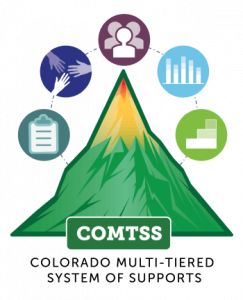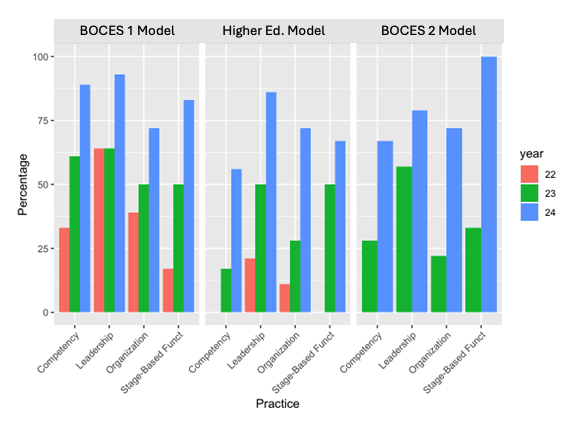Home > Implementation for Educators Blog
Co-Designing Regional Models for Colorado Multi-Tiered System of Supports

How does one get support for Multi-tiered System of Supports implementation to 179 districts, 1,927 schools, 55,197 teachers and 4,341 administrators to help them build capacity to meet the needs of a state’s 883,264 public school students? The secret ingredient to doing so may just be a regional infrastructure. The Colorado Department of Education’s Office of Learning Supports is in the middle of co-designing and testing regional infrastructures for their Multi-tiered System of Supports implementation with the support of the SISEP TA Center. This is the story of how we are doing so and what we are learning thus far in this transformative journey.
Why co-design regional structures to support Multi-tiered System of Supports implementation?
Given the sheer number of districts, schools, educators, and students in the state of Colorado, the Colorado Multi-Tiered System of Supports (COMTSS) team would need significantly more staff and resources to provide effective implementation support at scale. Data is lacking in the research literature to support an implementation ratio of 1 state implementation team to 179 school districts and their respective schools, teachers, and administrators. In addition, there is not one stable regional configuration currently in the state. Various regional configurations are in use by different units/offices within the state department of education, such as regions being defined geographically or by the number of staff within a unit available to serve the districts. In addition, state legislation funding (HB 121345) was given to Board of Cooperative Educational Services (BOCES) to better target the needs of districts and schools in each of the BOCES regions.
Multi-tiered System of Supports was being identified as an effective approach to address the unique needs in different BOCES regions. As a result, several BOCES had engaged in the COMTSS work with districts across the state. Under a new COMTSS grant, the Office of Learning Supports wanted to pilot regional models to cast a wider net of support. For these various reasons, a regional infrastructure was invested in for development.
How did we begin our regional implementation?

We took an iterative learning and co-design approach. A one size fits all approach to regional structure may not work for our state’s context. We began our empathy and exploration work by conducting interviews with key community partners (e.g., BOCES staff, district leaders and staff, and agencies serving youth in various areas such as mental health and academic support) in two rural areas of the state. The BOCES within these areas had demonstrated a level of interest, willingness, and commitment to COMTSS implementation through previous engagement in COMTSS learning opportunities as grantees, as well as through exploration meetings with leaders and other community agencies, such as Boys and Girls Club. Through the empathy interviews and focus groups processes, key learnings emerged to inform the development of a COMTSS Regional Implementation Team (C-RIT) in each region as well as a need for a more cohesive approach to supporting schools within rural communities. In the beginning there were two BOCES who participated in the COMTSS learning opportunities as grantees who went on to form C-RITs in each region. These two BOCES then began to define and ideate–through a needs assessment and data analysis protocol–their precise problem statement of need, an understanding of system factors contributing to the need within a region, and a clear area of focus within their COMTSS implementation. Within a year of these two BOCES creating C-RITs, another regional team joined the COMTSS regional pilot.
What has happened as a result of this work?
Three regional models have emerged with some trial and learning that accounted for the unique context of each rural area. The unique features of each regional model are described in the table. For example, one regional model is a Higher Education model, where the lead and the administrative home of the Regional Implementation Team is housed within a local University. In the two other regional models, the lead and administrative home of the Regional Implementation Team are housed within the BOCES regional education agency, however distinctions exist in how funding is allocated. Check out the other unique differences.
Table 1. Unique Characteristics of Each Regional Model
| Higher Education Model | BOCES 1 | BOCES 2 |
| Team composition: The COMTSS Regional Coordinator is located at the university and supports the regional implementation team made up of COMTSS district coordinators, representatives and community partners. This model is supported at the state level by 1 COMTSS Regional Lead and two COMTSS Specialists. | Team composition: COMTSS Regional Coordinator is located at the BOCES and supports the regional implementation team made up of COMTSS district coordinators and other district representatives (e.g., Superintendent, Asst. Superintendent). This model is supported at the state level by 1 COMTSS Regional Lead. | Team composition: The COMTSS Regional Coordinator is located at the BOCES and supports the regional implementation team made up of COMTSS district coordinators This model is supported at the state level by 1 COMTSS Regional Lead. |
| Funding Streams: COMTSS grant funds went to the district and to the Institute of Higher Education (split) | Funding Streams: COMTSS grant funds went to the BOCES and their districts (split) | Funding Stream: COMTSS grant funds went to the BOCES to distribute to participating districts |
| Goal Statement: By May 2026, the Regional Implementation Team will support San Luis Valley school districts in ensuring Data Systems are in place to address each district’s goals, implementation of COMTSS, integrate School Mental Health practices, and intentionally build Family, School, and Community Partnering practices to increase students’ well-being, resilience, and learning. These efforts will lead to a 20% decrease per year (total 86) of disciplinary removal (suspensions & expulsions). | Goal Statement: By May 2026, with access to effectiveness and selection tools provided by the BOCES within the 2022-2023 school year, 50% of BOCES districts will evaluate any new PD and will create a formal and standardized process in the selection process of all district PD, and the BOCES will lower the student risk ratio by 0.07 per year (to 1.23). | Goal Statement: By 2026, with training and coaching support, Santa Fe Trail BOCES will refine our Response to Intervention at the regional level including training of 100% of support staff and have less than 5% of incomplete or inappropriate referrals. |
There are several common core features of the regional model present across all three, including:
- Coordinator of Regional Implementation Team
- A Regional Implementation Team
- Implementation focus of COMTSS Core Components for their specific regional needs
- Ensuring implementation supports for COMTSS are provided in collaboration with the COMTSS State team such as training, coaching, data, communication, and leadership supports.
- Use of Regional Capacity Assessment (RCA) to guide action planning and monitor their teams’ growth in the ability to use implementation science practices to support their COMTSS work
- Regional and district coordinators participate in state-led COMTSS learning opportunities including the COMTSS Online Academy
- Receiving coaching support from CDE COMTSS Regional Specialists
- Using specific regional COMTSS tools, resources and guidance such as the COMTSS Regional/District/School Practice Profiles
What are our key takeaways from this work?
A key outcome of an iterative co-design process is LEARNING, both the intentional and the unintentional. A couple of our key learnings to date are:
- Co-creation of a COMTSS Regional Implementation Guide to provide a roadmap for replication and scaling purposes.
- Ensure regions have access to data they need from all districts in order to monitor and improve learning.
- Greater community involvement is creating collective accountability for implementation and support of students. Community partners are integrated fully into the work and greater brokering and leveraging of community resources are taking place.
- The regional models are demonstrating progress in building their internal infrastructure to support COMTSS implementation (see Figure 1: RCA Data most recent Total scores).
- Trusting relationships are key to creating and maintaining momentum in implementation.
Figure 1. Regional Capacity Assessment Data

Will a regional model be a means of providing effective support for COMTSS implementation to 179 districts, 1,927 schools, 55,197 teachers and 4,341 administrators to help them build capacity to meet the needs of a state’s 883,264 public school students? Our hope is to improve outcomes by creating a sustainable regional infrastructure that can better serve educators, families, and students. Stay tuned and follow our journey at COMTSS.

